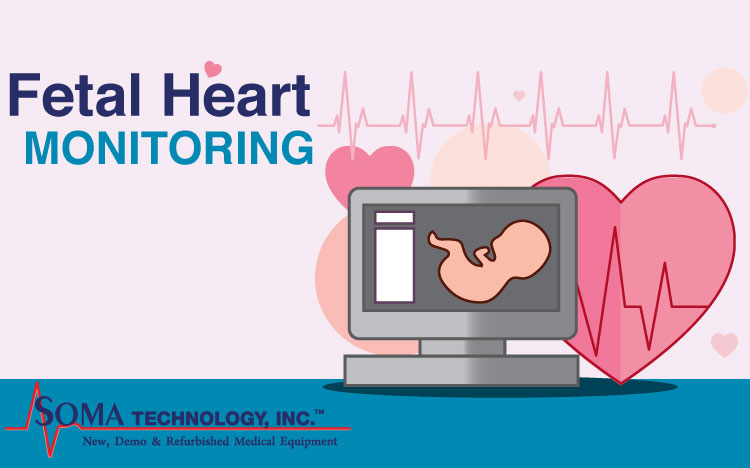Fetal Heart Monitor
June 11, 2019
Fetal Heart Monitor
What is a Fetal Heart Monitor?
Monitoring your fetus during labor and the tail end of your pregnancy is a common practice. A fetal heart monitor is used to check the rate, rhythm, and accelerations or decelerations of the fetal heartbeat. The average heartbeat for a fetus is between 110 and 160 beats per minute and may change due to the conditions in the uterus. If the fetal monitor detects there is an abnormal heart rate, that could mean the fetus is not getting enough oxygen or can be indicative of other problems. Sometimes the OB-GYN or your healthcare professional will say that cesarean delivery is needed. It is important to remember that an abnormal heart rate does not always mean that the fetus is in danger.
When Electronic Fetal Monitoring (EFM) is used, two main components are monitored. The first is the heart rate and the second is the contractions of the uterus. If you have been in labor then you might remember a nurse attaching two belts, each with a circle sensor on them. Both of these sensors are linked to a fetal monitoring device such as the Philips Avalon FM50. The Avalon FM50 is a sophisticated fetal heart monitor that also has the option to non-invasively monitor maternal vital signs as well as the vitals of the fetus. Continue reading to learn more about a fetal heart monitor!
The sensors send and detect data that is interpreted by the fetal recording device and show the baby’s heart rate and mother’s contractions on printed paper or display on the device. The heart rate and contractions shown together are often called EFM tracings. Once the baseline is set for the heart rate of the fetus, the device will then assess the changes in the heart rate with the mother’s contractions.
How is Fetal Monitoring Performed?
- First, a gel is applied to the mother’s abdomen that acts as a medium between the skin and the ultrasound transducer.
- Second, the ultrasound transducer is attached to the abdomen with a belt to help keep it in place.
- Third, to monitor contractions a second sensor is placed on the abdomen to monitor maternal contractions. This sensor is called a tocodynamometer.
Abnormal Fetal Heart Rate?
If your fetal heart rate is abnormal this does not always mean that there is a problem. Your OB-GYN or healthcare professional will perform other tests to get an idea of what is going on. Steps can be taken to help the baby get more oxygen like changing your position. If these procedures do not work, your OB-GYN may decide to deliver right away.
Internal Fetal Heart Monitor?
The method or monitoring your baby’s heart rate above is called external fetal monitoring. You may have also heard of internal fetal monitoring, but what is internal fetal monitoring?
An internal fetal heart monitor utilizes an electronic transducer that is smaller than the one used for external monitoring. This transducer is connected directly to the baby’s skin. This transducer electrode is typically attached to the scalp or another body part that is accessible through the cervical opening. The electrode is sometimes called a scalp electrode. Internal fetal monitoring provides a more accurate and consistent analysis. Your OB-GYN or healthcare professional may put in an internal fetal monitor electrode if monitoring the fetal heart rate externally is inadequate, or closer surveillance is needed.
How do Fetal Monitors Work?
A fetal heart monitor detects FHR (Fetal Heart Rate) by using an ultrasound transducer to transmit and receive ultrasonic waves. The Frequency shift of the reflected signal is proportional to the velocity of the reflecting structure. A transducer contains one or more piezoelectric elements that convert an electrical signal into ultrasonic energy that can be transmitted to tissues. When the ultrasonic energy is reflected from the tissues, the transducer reconverts it back to an electrical signal that is interpreted by the fetal monitor device and displayed on the screen or a printout.
Why do I Need a Fetal Monitor?
A fetal heart monitor is used in nearly every pregnancy to assess fetal well-being and identify any changes that might be associated with problems during pregnancy or labor. Monitoring the fetal heart rate is especially crucial for high-risk pregnancy conditions such as problems with fetal growth, high blood pressure, and diabetes. Some situations that might affect the heart rate are: uterine contractions, medicates, and pushing during labor.
Final Thoughts
Are you an OB-GYN or healthcare professional? Have you used a fetal monitor before? What fetal monitor did you use? Let us know in the comments below!
Explore Other Blog Items By Category
Recent Posts


Surgical Microscope Rentals

